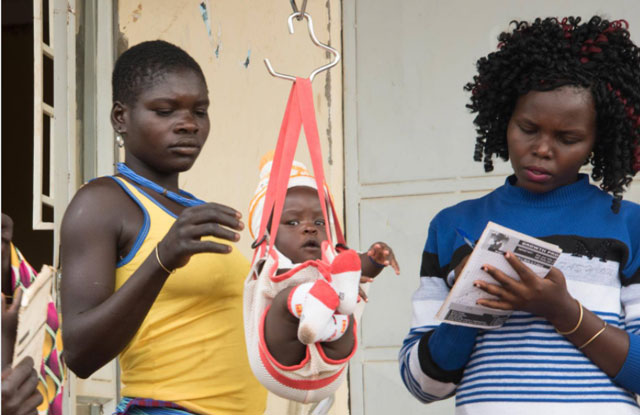
Can govt tap into the country’s relentless population boom?
Kampala, Uganda | RONALD MUSOKE | Uganda has the second youngest population in the world and this is only expected to increase over the coming decades as the number of children, adolescents and youth in the country is forecasted to rise from 27.5 million in 2015 to 75.9 million in 2080. The country’s population structure which population and development experts say is constructed like a pyramid is said to be“bottom heavy” meaning a huge proportion of the population is comprised of children and other young dependants who end up burdening the fewer working adults.
But the government wants to turn around this population structure to hit the “demographic dividend”—a term that refers to a situation where the majority of the population is in the working age loop. This structure brings enormous economic benefits to the country.
But, can Uganda tap into this demographic dividend or it is just one big illusion? Experts say while the benefits of harnessing the demographic dividend are well understood, how to get there is often less clear. In a four-part series, The Independent’s Ronald Musoke unpacks what Uganda must do to gainfully tap into its ever burgeoning population.
****
Dr. John Ssekamatte-Ssebuliba, a population and development expert says Uganda’s demographic history has been characterized by high and constant fertility with an average Ugandan woman bearing seven children in her reproductive life (15-49 years). It has also been characterized by a high mortality although this is now declining.
The result, Dr. Ssekamatte says, has been rapid population growth with an unfavourable age structure characterized by a high population of children, a smaller share of working age people and few old people. This, he says, explains the high child dependency burden in Uganda.
But, according to the 2021 State of Uganda Population Report published in November, last year, Uganda is showing signs of a demographic transition—a situation where birth and death rates shift from high to low levels in a population. This, the report said, is important in achieving Uganda’s dream: the demographic dividend.
In their 2019 paper, “Amplifying Understanding of the Demographic Dividend in Uganda,” Stella Kigozi, an expert on population matters at the National Population Council-Uganda and Elizabeth Leahy Madsen and Kaitlyn Patierno of the Washington DC-based Population Reference Bureau described the demographic dividend as “accelerated economic growth that happens when a population age structure matures and the dependency ratio falls, generating an increase in the proportion of the working age population.”
The International Planned Parenthood Federation (IPPF) in their policy brief published in 2013 noted that this opportunity arises after a demographic transition. The decline of mortality usually precedes the decline in fertility, resulting in rapid population growth. This happens in a four phase process, explains Dr. Jotham Musinguzi, the Director General of the National Population Council-Uganda.
In the first phase, death rates and birth rates are high. In the second phase, death rates drop rapidly due to various improvements in social and economic development while in the third phase, birth rates fall in part due to access to family planning. In the fourth phase, birth rates and death rates are low.
Uganda’s unique position
Experts say Uganda is uniquely positioned to harness the economic and social benefits of a young and growing dynamic population. But, the same experts quickly add that “the optimized relationship between population growth and accelerated economic growth, also referred to as the “demographic dividend” is or will not be automatic.”
They say harnessing the demographic dividend hinges on key and strategic public investment choices. First, it is critical that the dependency ratio— the share of working age adults to children— continues to decline.
The population decline must be accompanied by the government prioritizing education, health and protection of children since reaping the demographic dividend requires a health and educated workforce.
According to a year-long study that examined the changing youth demographics in four East African Community (EAC) countries; Kenya, Uganda, Tanzania, and Rwanda, the window of opportunity for these countries to harness their dividend is open from now until 2080 or 2100.
The study which was launched in Kampala in 2018 revealed that Uganda, however, stands out in stark contrast as the country with the highest rate of fertility within this group, and it is not declining fast enough either. Uganda’s fertility rate has reduced by only two children per woman over a thirty-year period, to the current 5.4 children average.

The study attributed Uganda’s high fertility to the early onset of childbearing and marriage, the low socio-economic status of women, low levels of female education, and poor access to contraception, especially among rural women and youth, and socio-cultural norms that place preference on women having many children.
Uganda has several policies developed in response to its growing youth population. Some of these include the National Youth Policy, the third National Development Plan (2020-2025) and Uganda’s grand development blueprint— Vision 2040.
These all recognize the double-edged nature of a large youthful population to Uganda’s future development prospects and propose strategic interventions that, if implemented, have the potential to influence the socio-economic trajectory of the country, and place it onto the path towards a sizeable demographic dividend.
Uganda’s Vision 2040 which the government formulated in 2010 seeks to transform Ugandan society from a peasant to a modern and prosperous country within 30 years with a per capita GDP increasing from US$ 506 in 2010 to US$ 9,500 by 2040.
It has been over a decade since Vision 2040 was formulated but Uganda is still grappling with challenges such as teenage childbearing, poor access to contraception, and HIV/AIDS—perhaps an indication that the government’s policies have not been effectively implemented.
Experts say the population in countries like Uganda will keep growing, a situation which will keep straining the country’s meagre resources and services such as education, jobs, and healthcare.
They say the price of inaction for Uganda is simply too great, as uneducated, unskilled, unemployed, and deprived youth can also become agents of social unrest, crime, and violent extremism.
These countries must invest in critical sectors urgently, if the prospects for a demographic dividend are to be realised. The experts say among the pre-requisites for harnessing the demographic dividend are; improved child survival, increased access to family planning, reduction in the unmet need for family planning and keeping girls in school up to tertiary level as well as preventing teenage pregnancy.
Within the healthy sector, it is important to promote preventive healthcare. This, they say, can be done by establishing universal health insurance, improving children’s health through immunization and nutrition programmes as well as ensuring access to health services, including reproductive health and family planning.
In the education sector, there are calls for the promotion of early childhood development programmes, shifting the primary and secondary school level to competence based education while ensuring that children who enter the education cycle are kept there up to completion.

Statistical analysis based on the experience of countries that have passed through the demographic transition shows that specific development benchmarks in sectors like education become available as fertility declines and median age rises.
For example, at a median age of 16 years—the current median age of Uganda—a given country has a 10% likelihood of reaching lower middle income status and a 1% likelihood of being classified as upper middle income.
Modelling Uganda’s population prospects
While developing Uganda’s third national development plan covering 2020/21—2024/25, experts at the Uganda National Planning Authority (NPA) tried to model the country’s population profile and provided policy options and targets towards the realization of Uganda’s demographic dividend to inform the future direction of the country’s planning.
The modelling was done using the DemDiv Model and covered a 23 year period with the base as 2017 and the end period as 2040. The choice of the base period was premised on the point of convergence of the most data sets available and the following assumptions were made with respect to the status of the economy in 2040.
The findings of the modelling showed that because of the momentum already built, Uganda’s population will continue to grow irrespective of whether the government puts more emphasis on the economic policies than in the second scenario where a combination in both economic and targeted interventions is in both the education and health sectors.
The NPA experts noted that introducing economic reforms without associated improvements in the quality of human capital would increase Uganda’s GDP from 2017 level of US$27.9bn to US$ 495bn in 2040. The associated GDP per capita would be US$ 6,735.
The modelling also showed that Uganda’s economy would grow faster if the combined model that concurrently prioritizes job-oriented economic reforms and investments in human capital are implemented, starting in 2018. Under this approach, Uganda could attain the Vision 2040 target of being a high middle income country in 2040 with a GDP per capita of US$ 9,523.
The country’s declining child mortality rate and increasing female life expectancy also provide hope for the potential initiation of the demographic transition-— phenomenon that underlines the fact that Uganda’s age structure is more important than just its population size when considering future economic opportunities.
While Uganda’s total fertility rate is showing signs of decline, further pro-poor social and economic development policies are needed in to improve education and health outcomes, increase formal labour force participation and come closer to the replacement rate of 2.1 children per woman, a key precondition to achieve the demographic dividend.
The government must therefore invest and implement appropriate policies to initiate this transition, create an environment for a skilled and healthy future labour force in order to reap the benefits of the demographic dividend—accelerated economic growth.
On the other hand, if left untouched, the current policies could constitute a major barrier to social transformation and development in Uganda and may hinder the achievement of its 2040 national development agenda.
Eve Brecker, a policy advisor at the Population Reference Bureau recently told journalists undergoing training on reporting on Uganda’s population, family planning and the demographic dividend that if current trends persist, Uganda is unlikely to attain a median age that is conducive to achieving these goals until after 2050. “(However), if the pace of fertility decline was accelerated, this timeline could move up,” she said.
****
 The Independent Uganda: You get the Truth we Pay the Price
The Independent Uganda: You get the Truth we Pay the Price



